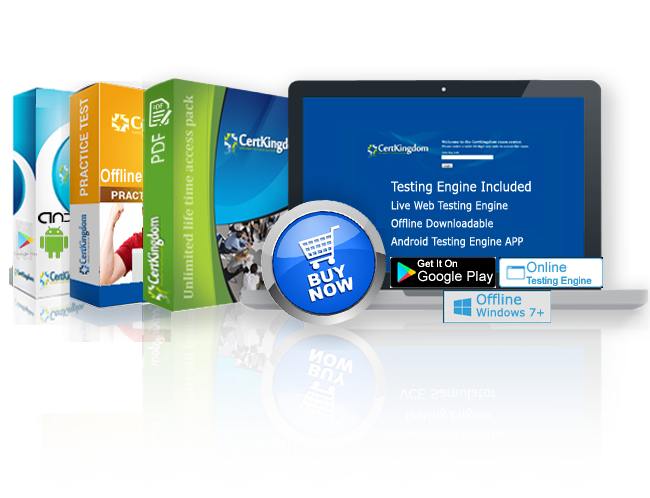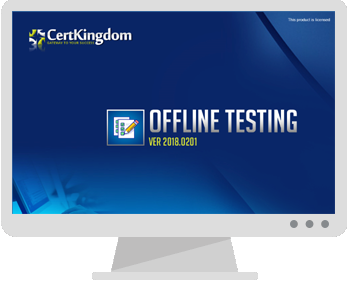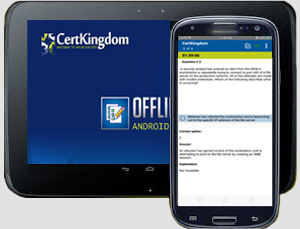Exam: 98-365

|
|||||||||||||||||||||||||||
Certkingdom's preparation material includes the most excellent features, prepared by the same dedicated experts who have come together to offer an integrated solution. We provide the most excellent and simple method to pass your certification exams on the first attempt "GUARANTEED"
Whether you want to improve your skills, expertise or career growth, with Certkingdom's training and certification resources help you achieve your goals. Our exams files feature hands-on tasks and real-world scenarios; in just a matter of days, you'll be more productive and embracing new technology standards. Our online resources and events enable you to focus on learning just what you want on your timeframe. You get access to every exams files and there continuously update our study materials; these exam updates are supplied free of charge to our valued customers. Get the best 98-365 exam Training; as you study from our exam-files "Best Materials Great Results"
98-365 Exam + Online / Offline and Android Testing Engine & 4500+ other exams included
$70 - $50 (you save $20)
Buy Now
Exam 98-365
Windows Server Administration Fundamentals
Preparing for an Exam
The Microsoft Certification website and this preparation guide contain a variety of resources to help you prepare for an exam. Preparing for and Taking an Exam — FAQ provides answers to frequently asked questions about exam registration ,preparation ,scoring ,and policies , including:
The most effective way to prepare to take an exam.
The relationship between Microsoft training materials and exam content.
Microsoft policy concerning the incorporation of service pack and revision updates into exam content.
Exam question types and formats.
Exam time limits and number of questions asked.
We recommend that you review this preparation guide in its entirety and familiarize yourself with the FAQs and resources on the Microsoft Certification website before you schedule your exam.
Audience Profile
Candidates for this exam are seeking to prove server administration knowledge and skills. Before taking this
This exam is designed to provide candidates with an assessment of their knowledge of fundamental server administration concepts. It can also serve as a stepping stone to the Microsoft Certified Technology Specialist exams.
Exam, candidates should have a solid foundational knowledge of the topics outlined in this preparation guide. It is recommended that candidates become familiar with the concepts and the technologies described here by taking relevant training courses. Candidates are expected to have some hands-on experience with Windows Server, Windows based networking, Active Directory, account management, and system recovery tools and concepts.
This training will cover
This exam measures your ability to accomplish the technical tasks listed below. The percentages indicate the relative weight of each major topic area on the exam.The higher the percentage, the more questions you are likely to see on that content area on the exam.
The information after “This objective may include but is not limited to” is intended to further define or scope the objective by describing the types of skills and topics that may be tested for the objective. However, it is not an exhaustive list of skills and topics that could be included on the exam for a given skill area. You may be tested on other skills and topics related to the objective that are not explicitly listed here.
Understanding Server Installation
Understand device drivers.
This objective may include but is not limited to: installation; removal; disabling; update/upgrade; rollback; troubleshooting; Plug & Play; IRQ; interrupts; driver signing
Understand services.
This objective may include but is not limited to: what services are; which statuses a service can be in; startup types; recovery options; delayed startup; Run As settings for a service; stopping or pausing a service; service accounts, dependencies
Understand server installation options.
This objective may include but is not limited to: choosing correct OS version; partitioning; F8 options; server core vs. full; interactive install; unattended install; automated install using WDS; upgrade vs. clean install; firmware updates including BIOS
Understanding Server Roles
Identify application servers.
This objective may include but is not limited to: mail servers; database servers; collaboration servers; monitoring servers; threat management
Understand Web services.
This objective may include but is not limited to: IIS, WWW, and FTP; separate worker processes; adding components; sites; ports; SSL; certificates
Understand remote access.
This objective may include but is not limited to: remote assistance; remote administration tools; Remote Desktop Services; licensing; RD Gateway; VPN; application virtualization; multiple ports
Understand the file and print services.
This objective may include but is not limited to: local printers; network printers; printer pools; web printing; web management; driver deployment; file, folder, and share permissions vs. rights; auditing; print job management
Understand server virtualization.
This objective may include but is not limited to: virtualization modes; VHDs; virtual memory; virtual networks; snapshots and saved states; physical to virtual; virtual to physical
Understanding Active Directory
Understand accounts and groups.
This objective may include but is not limited to: domain accounts; local accounts; user profiles; group types; group scopes; group nesting; AGDLP
Understand organizational units and containers.
This objective may include but is not limited to: purpose of organizational units; purpose of containers; delegation; default
Understand Active Directory infrastructure.
This objective may include but is not limited to: domain controllers; forests; operation masters roles; domain vs. workgroup; child domains; trusts; functional levels; namespace; sites; replication
Understand group policy.
This objective may include but is not limited to: group policy processing; Group Policy Management Console; computer policies; user policies; local policies
Understanding Storage
Identify storage technologies.
This objective may include but is not limited to: advantages and disadvantages of different storage types; local (SATA, SCSI, IDE); NAS; SAN; fibre channel; iSCSI; NFS; FC HBA and FC switches; iSCSI hardware
Understand RAID.
This objective may include but is not limited to: RAID 0, RAID 1, RAID 5, RAID 10 and combinations; hardware and software RAID
Understand disk types.
This objective may include but is not limited to: ATA; basic disk; dynamic disk; mount points; file systems; mounting a virtual hard disk; distributed file systems; optical disks
Understanding Server Performance Management
Identify major server hardware components.
This objective may include but is not limited to: memory; disk; processor; network; 32 / 64 bits; removable drives; graphic cards; cooling; power usage; ports
Understand performance monitoring.
This objective may include but is not limited to: methodology; procedures; effect of network, CPU, memory and disk; creating a baseline; perfmon; resmon; Task Manager; performance counters
Understand logs and alerts.
This objective may include but is not limited to: purpose of performance logs and alerts
Understanding Server Maintenance
Identify steps in the startup process.
This objective may include but is not limited to: bios; bootsector; bootloader; MBR; boot.ini; bcdedit; POST; Safe Mode
Understand business continuity .
This objective may include but is not limited to: backup and restore; disaster recovery; clustering; AD restore; folder redirection; data redundancy; uniterruptible power supply (UPS)
Understand updates.
This objective may include but is not limited to: software; driver; operating systems; applications; Windows Update; Windows Server Update Service (WSUS)
Understand troubleshooting methodology.
This objective may include but is not limited to: processes; procedures; best practices; systematic vs. specific approach; perfmon; Event Viewer; Resource Monitor; Information Technology Infrastructure Library; central logging; event filtering; default logs
Make yourself more valuable in today's competitive computer industry Certkingdom's preparation material includes the most excellent features, prepared by the same dedicated experts who have come together to offer an integrated solution. We provide the most excellent and simple method to pass your Microsoft Microsoft Technology Associate (MTA) 98-365 exam on the first attempt "GUARANTEED".
Unlimited Access Package
will prepare you for your exam with guaranteed results, 98-365 Study Guide. Your exam will download as a single 98-365 PDF or complete 98-365 testing engine as well as over +4000 other technical exam PDF and exam engine downloads. Forget buying your prep materials separately at three time the price of our unlimited access plan - skip the 98-365 audio exams and select the one package that gives it all to you at your discretion: 98-365 Study Materials featuring the exam engine.
Certkingdom 98-365 Exam Prepration Tools
Certkingdom Microsoft Microsoft Technology Associate (MTA) preparation begins and ends with your accomplishing this credential goal. Although you will take each Microsoft Microsoft Technology Associate (MTA) online test one at a time - each one builds upon the previous. Remember that each Microsoft Microsoft Technology Associate (MTA) exam paper is built from a common certification foundation.
98-365 Exam Testing Engines
Beyond knowing the answer, and actually understanding the 98-365 test questions puts you one step ahead of the test. Completely understanding a concept and reasoning behind how something works, makes your task second nature. Your 98-365 quiz will melt in your hands if you know the logic behind the concepts. Any legitimate Microsoft Microsoft Technology Associate (MTA) prep materials should enforce this style of learning - but you will be hard pressed to find more than a Microsoft Microsoft Technology Associate (MTA) practice test anywhere other than Certkingdom.
98-365 Exam Questions and Answers with Explanation
This is where your Microsoft Microsoft Technology Associate (MTA) 98-365 exam prep really takes off, in the testing your knowledge and ability to quickly come up with answers in the 98-365 online tests. Using Microsoft Technology Associate (MTA) 98-365 practice exams is an excellent way to increase response time and queue certain answers to common issues.
98-365 Exam Study Guides
All Microsoft Microsoft Technology Associate (MTA) online tests begin somewhere, and that is what the Microsoft Microsoft Technology Associate (MTA) training course will do for you: create a foundation to build on. Study guides are essentially a detailed Microsoft Microsoft Technology Associate (MTA) 98-365 tutorial and are great introductions to new Microsoft Microsoft Technology Associate (MTA) training courses as you advance. The content is always relevant, and compound again to make you pass your 98-365 exams on the first attempt. You will frequently find these 98-365 PDF files downloadable and can then archive or print them for extra reading or studying on-the-go.
98-365 Exam Video Training
For some, this is the best way to get the latest Microsoft Microsoft Technology Associate (MTA) 98-365 training. However you decide to learn 98-365 exam topics is up to you and your learning style. The Certkingdom Microsoft Microsoft Technology Associate (MTA) products and tools are designed to work well with every learning style. Give us a try and sample our work. You'll be glad you did.
98-365 Other Features
* Realistic practice questions just like the ones found on certification exams.
* Each guide is composed from industry leading professionals real Microsoft Microsoft Technology Associate (MTA)notes, certifying 100% brain dump free.
* Study guides and exam papers are guaranteed to help you pass on your first attempt or your money back.
* Designed to help you complete your certificate using only
* Delivered in PDF format for easy reading and printing Certkingdom unique CBT 98-365 will have you dancing the Microsoft Microsoft Technology Associate (MTA) jig before you know it
* Microsoft Technology Associate (MTA) 98-365 prep files are frequently updated to maintain accuracy. Your courses will always be up to date.
Get Microsoft Technology Associate (MTA) ebooks from Certkingdom which contain real 98-365 exam questions and answers. You WILL pass your Microsoft Technology Associate (MTA) exam on the first attempt using only Certkingdom's Microsoft Technology Associate (MTA) excellent preparation tools and tutorials.
These are real testimonials. Hi friends! CertKingdom.com is No1 in sites coz in $50 I cant believe this but when I purchased the $50 package it was amazing I Microsoft passed 10 Exams using CertKingdom guides in one Month So many thanks to CertKingdom Team , Please continue this offer for next year also. So many Thanks
Mike CA
Thank You! I would just like to thank CertKingdom.com for the Microsoft Microsoft Technology Associate (MTA) 98-365 test guide that I bought a couple months ago and I took my test and pass overwhelmingly. I completed the test of 413 questions in about 90 minutes I must say that their Q & A with Explanation are very amazing and easy to learn.
Jay Brunets
After my co-workers found out what I used to pass Microsoft Microsoft Technology Associate (MTA) 98-365 the test, that many are thinking about purchasing CertKingdom.com for their Microsoft Technology Associate (MTA) exams, I know I will again
John NA
I passed the Microsoft Microsoft Technology Associate (MTA) 98-365 exam yesterday, and now it's on to security exam. Couldn't have done it with out you. Thanks very much.
Oley R.
Hello Everyone
I Just Passed The Microsoft Microsoft Technology Associate (MTA) 98-365 Took 80 to 90 Minutes max to understand and easy to learn. Thanks For Everything Now On To 98-365
Robert R.
Hi CertKingdom.com thanks so much for your assistance in Microsoft Microsoft Technology Associate (MTA) i passed today it was a breeze and i couldn't have done it without you. Thanks again
Seymour G.
I have used your Exam Study Guides for preparation for Microsoft Microsoft Technology Associate (MTA) 98-365. I also passed all those on the first round. I'm currently preparing for the Microsoft and theMicrosoft Technology Associate (MTA). exams
Ken T.
I just wanted to thank you for helping me get myMicrosoft Technology Associate (MTA) $50 package for all guides is awesome you made the journey a lot easier. I passed every test the first time using your Guide
Mario B.
I take this opportunity to express my appreciation to the authors of CertKingdom.com Microsoft Microsoft Technology Associate (MTA) test guide. I purchased the 98-365 soon after my formal hands on training and honestly, my success in the test came out of nowhere but CertKingdom.com. Once again I say thanks
Kris H.
Dear CertKingdom.com team the test no. 98-365 that i took was very good, I received 880 and could have gain more just by learning your exams
Gil L.
Hi and Thanks I have just passed the Microsoft Technology Associate (MTA) Directory Services Design exam with a score of 928 thanks to you! The guide was excellent
Edward T.
Great stuff so far....I love this site....!! I am also on the Microsoft Microsoft Technology Associate (MTA) I decided to start from certkingdom and start learning study Microsoft Technology Associate (MTA) from home... It has been really difficult but so far I have managed to get through 4 exams....., now currently studying for the more exams.... Have a good day.................................................. Cheers
Ted Hannam
Thanks for your Help, But I have finally downloaded Microsoft Microsoft Technology Associate (MTA) 98-365 exam preparation from certkingdom.com they are provided me complete information about the exam, lets hope I get success for the 98-365 exam, I found there exams very very realistic and useful. thanks again
lindsay Paul
Certkingdom Offline Testing Engine Simulator Download
Prepare with yourself how CertKingdom Offline Exam Simulator it is designed specifically for any exam preparation. It allows you to create, edit, and take practice tests in an environment very similar to an actual exam.
Supported Platforms: Windows-7 64bit or later - EULA | How to Install?
FAQ's: Windows-8 / Windows 10 if you face any issue kinldy uninstall and reinstall the Simulator again.
Download Offline Simulator-Beta
Certkingdom Testing Engine Features
- Certkingdom Testing Engine simulates the real exam environment.
- Interactive Testing Engine Included
- Live Web App Testing Engine
- Offline Downloadable Desktop App Testing Engine
- Testing Engine App for Android
- Testing Engine App for iPhone
- Testing Engine App for iPad
- Working with the Certkingdom Testing Engine is just like taking the real tests, except we also give you the correct answers.
- More importantly, we also give you detailed explanations to ensure you fully understand how and why the answers are correct.
Certkingdom Android Testing Engine Simulator Download
Take your learning mobile android device with all the features as desktop offline testing engine. All android devices are supported.
Supported Platforms: All Android OS EULA
Install the Android Testing Engine from google play store and download the app.ck from certkingdom website android testing engine download

Certkingdom Android Testing Engine Features
- CertKingdom Offline Android Testing Engine
- Make sure to enable Root check in Playstore
- Live Realistic practice tests
- Live Virtual test environment
- Live Practice test environment
- Mark unanswered Q&A
- Free Updates
- Save your tests results
- Re-examine the unanswered Q & A
- Make your own test scenario (settings)
- Just like the real tests: multiple choice questions
- Updated regularly, always current




